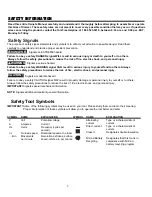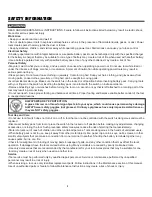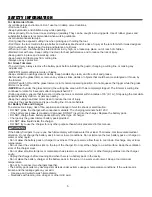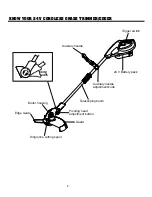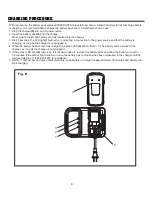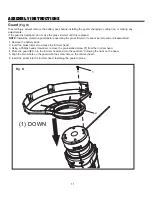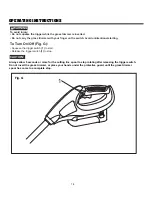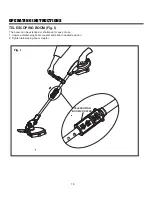
6
WARNING
Fig. B
Minimum Gauge for Extension Cords (AWG)
(when using 120 V only)
Ampere Rating
Total Length of Cord in Feet (meters)
More Than Not More Than
25' (7.6 m) 50' (15 m) 100' (30.4 m) 150' (45.7 m)
0
6
18
16
16
14
6
10
18
16
14
12
10
12
16
16
14
12
12
16
14
12
Not Recommended
2 Prong
Polarized Plug
Properly
Grounded
Outlet
Fig. A
Properly
grounded
outlet
2-pronged
polarized plug
READ AND UNDERSTAND ALL INSTRUCTIONS. Failure to follow safety rules listed below may result in electric
shock, fire, and/or personal injury:
• Do not abuse the cord. Never use the cord to carry the tool. Never pull on the cord to remove the plug from the power
outlet. Keep cords away from heat, oil, sharp edges, or moving parts. Replace damaged cords immediately. They may
create a fire. Do not use.
• Do not place the charger where the power cord might be stepped on, tripped on, or subjected to damage.
• A battery-operated tool with integral batteries or a separate battery pack must be recharged only with the specified charger
for the battery. A charger that may be suitable for one type of battery may create a risk of fire when used with another
battery.
• Use a battery-operated tool only with the specifically designated battery pack. Use of any other batteries may create a risk
of fire.
Grounding (Fig. A)
In the event of a malfunction or breakdown, grounding provides the path of least resistance for electric current, and reduces
the risk of electric shock.
This battery charger is double insulated and has a two-prong polarized plug (one blade is wider than the other). This plug
will fit into a polarized outlet only one way. If the plug does not fit fully in the outlet, reverse the plug. If it still does not fit,
contact a qualified electrician to install the proper outlet. DO NOT change the plug in any way.
IN ALL
cases, make sure the
outlet is properly grounded. If you are not sure, have a certified electrician check the power outlet.
Extension Cords (Fig. B)
Do not use an extension cord for the charger unless absolutely necessary. If you use an extension cord make sure the
cord is in good condition.
Use one heavy enough to carry the current your charger will draw. An undersized extension cord will cause a drop in line
voltage, resulting in loss of power and overheating.The table below shows the correct size of extension cord to use,
depending on cord length and the charger's ampere rating listed on the nameplate. If in doubt, use the next heavier gauge.
The smaller the gauge number is, the heavier the cord.
Make sure your extension cord is properly wired and in good condition. Always replace a damaged cord or have it repaired
by a qualified electrician. Protect your extension cord from sharp objects, excessive heat and damp or wet areas.
Use a separate electric circuit for your tools. Never use any other voltage or power source than common household 120 V
electrical power. The circuit must not beless than a #12 wire, and should be protected with a 15 A time-delayed fuse. Before
connecting the charger to the power line, make sure the electric current is rated the same as the current stamped on the
charger nameplate. To reduce the risk of disconnection of charger cordfrom the extension cord during operation, make a
knot (Fig. B).
SAFETY
INFORMATION
Содержание 60-2273-4
Страница 24: ...24 EXPLODED VIEW...



